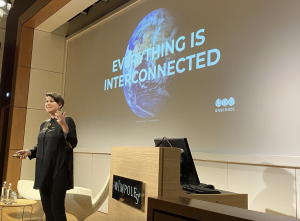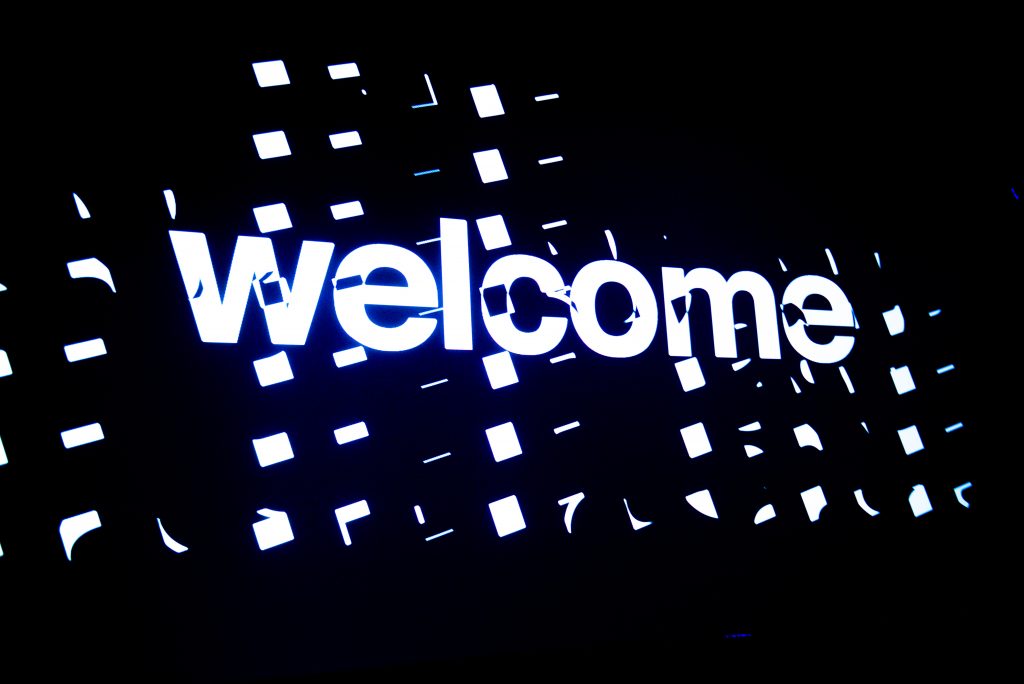
DBA Roundup
A roundup of industry expertise, exclusive resources, business support and tools for your design business.

Today, six of nine of our ‘planetary boundaries‘ for environmental self-regulation have been crossed with unknown but possibly catastrophic consequences for our natural world. An overriding global growth agenda has created an addictive consumption system with no value for nature, making money from ‘selling waste’ that consumes more resources than can be regenerated creating a zero-sum outcome. The same message delivered in Dr Suess’s ‘The Lorax’ a half century ago is now more than a cautionary tale.
Starting as a product designer, Dr Leyla Acaroglu (who is now a United Nations ‘Champion of the Earth’) had a formative experience that led to a powerful insight into the human mindset; why does one person care about the environment and another doesn’t?
Armed with this, she initially saw design as part of the problem until concluding that we need to be inside the system to change it, to understand the desired and undesired impacts of our choices and adopt ‘lifecycle thinking’ through a design mindset.
 Asking ‘if you were accountable for your actions what would you change?’, Leyla highlighted the agency (power and influence) designers have. If united, we would have tremendous opportunity to disrupt existing systems and business models. ‘After all,’ Leyla reminded us, ‘we know how to manipulate people,’ but we need to close the knowledge gap without shaming others. Swivel Skills, a learning platform founded by Leyla to help educate and train business on circularity and sustainability is a good place to start.
Asking ‘if you were accountable for your actions what would you change?’, Leyla highlighted the agency (power and influence) designers have. If united, we would have tremendous opportunity to disrupt existing systems and business models. ‘After all,’ Leyla reminded us, ‘we know how to manipulate people,’ but we need to close the knowledge gap without shaming others. Swivel Skills, a learning platform founded by Leyla to help educate and train business on circularity and sustainability is a good place to start.
Flagging one of the systemic problems with design – that it doesn’t always interrogate the system it is working in fully, it just deals with the intended outcome – Leyla discussed how design innovation is often focused on consumer behaviours that are locked into the established consumption system. Her recommendation: we should suspend the need to solve these from the get-go and have deeper curiosity about the system itself.
With companies increasingly required to report into Environmental, Social and Governance (ESG) frameworks, design can be a key sustainability line item. From a design perspective we are uniquely positioned to do the appraisal and deliver more value than a tool to create demand for business.
There is no waste in nature. Nature creates regenerative systems where everything optimises life. Yet nature is treated as if it has no value.
We heard how design led lifecycle approaches can help to uproot us from the ‘extractive economy’ to move to a circular and regenerative economy. But it can be hard to convince clients and their customers that it is better than the currently disposable status-quo.
Leyla was clear that design must focus on ‘elegantly disrupting the business model’, yet still needs to stimulate desire the same way when we execute commercially, to deliver a beautiful and frictionless service delivery experience that invites consumer participation. Ultimately, it’s a people and behaviour problem so design should ‘create the party everyone wants to go to,’ says Leyla, ‘as no one wants to go to the end of the world party’. This requires a holistic approach taking in all aspects of design from product and content to positioning and style.
 Start by identifying the primary and secondary purpose of the product, whether it’s protection, performance, status etc, and assess the product’s current linear lifecycle, from material extraction to end-of-life scenarios. From there we can work out how to transform it.
Start by identifying the primary and secondary purpose of the product, whether it’s protection, performance, status etc, and assess the product’s current linear lifecycle, from material extraction to end-of-life scenarios. From there we can work out how to transform it.
Leyla’s design toolkit features five main lifecycle stages. And data based lifecycle assessment tools can help map impacts to further enable the design process. There are plenty of tools out there from Plan A to Greenly and they can help build business arguments and justifications.
Design circular business models to underpin ‘product as service’ systems that focus on reuse. Consider everything from packaging design and material specifications to takeback programs, subscription services etc. And if you can’t make it reusable, how do you make it repairable, or enable materials to be recaptured and remanufactured?
Further design strategies from upcycling to recycling can help keep materials in the system for as long as possible. And if you can’t find a circular pathway then make sure design considers the product’s end of life destination. From there you must figure out how to implement the circular system in place of the linear system and manage the trade-offs. And don’t forget that you still need to make the product and service experience enjoyable to create consumer participation.
Ultimately, it’s about action. Right now.










 When it comes to our own websites, agencies are frequently guilty of starting with the styling, not the message. Exactly the type of thing we warn clients against. It can quickly become a one-dimensional creative project that people get excited about in the studio, rather than a brand positioning and design project. The website can be a great vehicle for re-thinking the agency’s difference. So, before a creative gets near the website, get the thinking right. Research what clients are looking for, review your competitors’ sites, run a workshop to look at some key questions. Who are we, what do we do, how do we do it and why do we do it are very simple questions, but they can be incredibly difficult to answer. Do all those things that you’d normally do for a client project that can easily fall by the wayside for an internal project. Treat it with the same rigour.
When it comes to our own websites, agencies are frequently guilty of starting with the styling, not the message. Exactly the type of thing we warn clients against. It can quickly become a one-dimensional creative project that people get excited about in the studio, rather than a brand positioning and design project. The website can be a great vehicle for re-thinking the agency’s difference. So, before a creative gets near the website, get the thinking right. Research what clients are looking for, review your competitors’ sites, run a workshop to look at some key questions. Who are we, what do we do, how do we do it and why do we do it are very simple questions, but they can be incredibly difficult to answer. Do all those things that you’d normally do for a client project that can easily fall by the wayside for an internal project. Treat it with the same rigour.
 88% of clients want a website to quickly show them what an agency is best at. With so many agencies offering so many services, this can be difficult. Nailing and articulating how and where you excel is crucial. Remember that this isn’t necessarily a particular service. It can equally be the way you think or the way you approach challenges. In a new business context, clients need fast extraction of useful information. In other words, they are looking for speedy answers to questions such as what the agency is best at, do they have relevant experience that fits the client’s strategic challenges and what would they be like to work with? 59% of clients stated an increased need for creative work to demonstrate a return on investment, so clearly flagging up your work’s commercial effectiveness is always powerful. Above all, never lose sight of your website’s main purpose. It’s really about whetting the client’s appetite enough that they might want to meet you. Primarily, the website is there to sell a meeting. We need to make it easy for them. Clear and compelling messaging is key.
88% of clients want a website to quickly show them what an agency is best at. With so many agencies offering so many services, this can be difficult. Nailing and articulating how and where you excel is crucial. Remember that this isn’t necessarily a particular service. It can equally be the way you think or the way you approach challenges. In a new business context, clients need fast extraction of useful information. In other words, they are looking for speedy answers to questions such as what the agency is best at, do they have relevant experience that fits the client’s strategic challenges and what would they be like to work with? 59% of clients stated an increased need for creative work to demonstrate a return on investment, so clearly flagging up your work’s commercial effectiveness is always powerful. Above all, never lose sight of your website’s main purpose. It’s really about whetting the client’s appetite enough that they might want to meet you. Primarily, the website is there to sell a meeting. We need to make it easy for them. Clear and compelling messaging is key.
 Most clients don’t have the time or inclination to wade through dense case studies on your website. 91% of clients prefer agency websites with less copy, so keep them short and concise. It’s more about sharp, pithy statements and a visual story. There are two other reasons for keeping case studies ruthlessly short. Firstly, if you’ve already told the detailed story of the project, what are you going to tell them when you meet? Secondly, agencies need to tell client stories differently, depending on who you are talking to. Keeping web case studies short gives you the flexibility to do this when you actually meet the potential client. The days of having a pre-prepared bank of case studies, applicable to multiple potential clients, should be over. We’re not librarians. Instead, the modern agency should be a curator of case studies, re-engineering case studies to be pinpoint relevant to a particular client and the strategic issues they are facing.
Most clients don’t have the time or inclination to wade through dense case studies on your website. 91% of clients prefer agency websites with less copy, so keep them short and concise. It’s more about sharp, pithy statements and a visual story. There are two other reasons for keeping case studies ruthlessly short. Firstly, if you’ve already told the detailed story of the project, what are you going to tell them when you meet? Secondly, agencies need to tell client stories differently, depending on who you are talking to. Keeping web case studies short gives you the flexibility to do this when you actually meet the potential client. The days of having a pre-prepared bank of case studies, applicable to multiple potential clients, should be over. We’re not librarians. Instead, the modern agency should be a curator of case studies, re-engineering case studies to be pinpoint relevant to a particular client and the strategic issues they are facing.
 22% of clients believe that some agency websites defy credibility – ‘Can an agency of 15 people really deliver that long list of services? How on earth are they able to monitor global trends?’ Clearly, you need to avoid hype and over claim, but remember that the agency website is an opportunity to set out your stall for the future. It’s aimed at the clients you want to attract, the types of project you want to win. For small/medium sized agencies, the website is often an opportunity to punch above your weight. So, think about the messages that support that and which messages might detract. For instance, overly humorous people profiles can easily convey your agency as small. Do you show everyone in the agency or just ‘key people’? Does segmenting your work by industry sectors merely show up the gaps in your experience? Is your website just a glorified portfolio with additional news, or are you sharing an authentic viewpoint?
22% of clients believe that some agency websites defy credibility – ‘Can an agency of 15 people really deliver that long list of services? How on earth are they able to monitor global trends?’ Clearly, you need to avoid hype and over claim, but remember that the agency website is an opportunity to set out your stall for the future. It’s aimed at the clients you want to attract, the types of project you want to win. For small/medium sized agencies, the website is often an opportunity to punch above your weight. So, think about the messages that support that and which messages might detract. For instance, overly humorous people profiles can easily convey your agency as small. Do you show everyone in the agency or just ‘key people’? Does segmenting your work by industry sectors merely show up the gaps in your experience? Is your website just a glorified portfolio with additional news, or are you sharing an authentic viewpoint?
 We all want to know more about people and organisations more quickly. What really makes the agency tick? This is the agency story, the emotional part of the sell. Also, what’s your view on the world? What are your beliefs? Go beyond the standard ‘About us’ – reveal yourself. Answer the question, ‘Would I want to meet these people?’
We all want to know more about people and organisations more quickly. What really makes the agency tick? This is the agency story, the emotional part of the sell. Also, what’s your view on the world? What are your beliefs? Go beyond the standard ‘About us’ – reveal yourself. Answer the question, ‘Would I want to meet these people?’










There was much, much more covered in the hour – you really had to be there. Do make sure you join us in our next DBA Members’ Forum on Monday 2 October at 4pm BST, look out for an email from me in a few weeks with more details. If you would like to attend, get in touch here.









